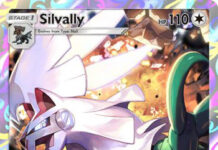
Battle Frontier
– Emerald
Date Reviewed:
March 7, 2019
Ratings Summary:
Standard: N/A
Expanded: N/A
Limited: 4.00
Ratings are based on a 1 to 5 scale. 1 is horrible. 3 is average. 5 is great.
Reviews Below:
 Vince Today’s Throwback Thursdays is Battle Frontier (EX Emerald 75/106, EX Power Keepers 71/108). This is a Stadium card which states that each player’s Colorless, Dark, and Metal Evolved Pokemon cannot use any Poke-Power or Poke-Bodies. I did not Ctrl-F search, so unless I’m missing something, here’s a older review from September 1, 2006. The ability to shut off abilities can be brutal to decks that heavily rely on it, as they’ll render them helpless. Now, I’m not around the time where this card was modified legal. I started playing around 2010, but this card is from 2006. Due to this, I am not certain how useful this card was back then, but I’m pretty sure that it must have been useful back then. This stadium may be niche and specialized, but it still shuts down a handful of Pokémon of these types and evolution stage. Pidgeot cannot utilize Quick Search while this stadium’s Active; Scizor-ex cannot benefit from extra damage from Danger Perception; and much much more. When none of these application applies, it can be as useful as kicking off other Stadiums. It is possible to play this card for zero benefit, similar to how Parallel City has been used. If this were to be reprinted – which could’ve happened somewhere in Celestial Storm because this set focuses on Neo-era and ex-era modernized cards – the text would hypothetically be updated to shut off Abilities of Evolved Colorless, Metal, and Darkness Pokemon. If that was the case, it would see a lot of play to cause inconvenience to the opposing deck that heavily relies on abilities from those types. Ratings: N/A for Standard & Expanded Limited: 4.5/5 |
 Otaku Today we’re looking back at Battle Frontier (EX – Emerald 75/106; EX – Power Keepers 71/108), an old Trainer-Stadium with an effect that disables the Poké-Powers and Poké-Bodies of Evolved [C], [D], and [M] Pokémon. This is going to require a lot of explaining. Before we even get into what Poké-Bodies and Poké-Powers are, you need to understand how being restricted to just Evolved Pokémon and just these three Types were benefits. Most of you have probably only ever experienced metagames where being a Basic was the best; that is how it was in the days of the Base Set, and to a lesser extent, the days of Jungle, Fossil, Base Set 2, Gym Heroes, and Gym Challenge. There were exceptions, but the Basic Pokémon of the Neo, e-card, and EX series varied from slightly to badly nerfed. During this period, most Basic Pokémon were filler. There were many exceptions but not enough to create a deck like Haymaker. This was a time when Evolutions were often much, much more powerful than non-Evolving Basic Pokémon. Things began to change with the early DP-era, and by the end of the Platinum-era, almost all Stages of Evolution were broken as we had ways of accelerating Evolutions, bolstering Basics, and oddball mechanics like Level-Up (LV.X) Pokémon. Battle Frontier’s first release was just in time to catch the last few months of the 2004-2005 Standard Format. Battle Frontier was legal for the entirety of the 2005-2006, 2006-2007, and 2007-2008 Standard Formats. During this time, Rare Candy worked differently; it let you immediately Evolve a Basic Pokémon, the first turn that Pokémon was in play and – barring some of the “first turn” rules implemented during this period – even on the very first turn of the game (always during the first turn of the player going second). Give or take some rulings confusion, anyway; the infrastructure we have now was out of its infancy back then, but still far from mature. Rare Candy also let you Evolve into either the corresponding Stage 2 or Stage 1. I’m sure some of you must think this had to be the best time to be a Pokémon player, and it very well may have been… but not because the (lack of) balance between the Stages had been flipped. Think of how many Basic Pokémon there are versus how many Evolutions there are; ignorance kept many of us from realizing exactly how much “filler” was in each set. Instead of Stage 2 Pokémon being all-but-guaranteed duds, it was the much more numerous Basic Pokémon! I’ve covered why only applying to Evolutions was probably a benefit – they were the driving force of the metagame and this gave some Basics a bit of a boost. Now… what are Poké-Bodies and Poké-Powers? Originally, the “non-attack effect” of Pokémon cards were called Pokémon Powers. They worked almost exactly like Abilities, just with a different name. The game’s mechanics consider them completely different things, despite the similarities. The powers-that-be released some effects that applied to all Pokémon Powers… and they proved to be a little too powerful. Players also were confused by some Pokémon Powers working when you chose to use them, and some being on all the time. So Pokémon Powers were divided into Poké-Bodies (the ones always on) and Poké-Powers (the ones that needed to be intentionally activated). They each also still counted as Pokémon Powers, so older effects that stated they worked on Pokémon Powers would still apply to Poké-Bodies and Poké-Powers. Surprisingly, the then new cards with effects that stated they applied to both Poké-Bodies and Poké-Powers (like today’s card) were ruled to also apply to old-school Pokémon Powers. Which finally brings us to the metagame (and even general cardpool) of the time when Battle Frontier was released and Standard-legal. As you would expect, [C] Type Pokémon were common. [D] and [M] Pokémon were less common than [C] Types but more common than they are now. Why? Set gimmicks. 14 months before Battle Frontier released, we received the EX – Team Magma Vs Team Aqua expansion, which contained several dual-Typed Pokémon. Instead of using this rare mechanic to represent accurate video game Type pairings, it was so that many (but not all) of these Pokémon were [D] Typed (plus whatever their usual TCG Type would be). This was so that they could access certain [D] support and represent how their evil Trainers had influenced them. Six months before Battle Frontier released, this approach was also taken with many of the Pokémon released in the EX – Team Rocket Returns expansion. About five months later, EX – Delta Species introduced “Pokémon δ”, which were Pokémon that were the “wrong” Type. Again, it featured many dual-Type Pokémon but this time, many things were part [M] Type when they usually wouldn’t have been [M] Type at all. Put it all together, and [D] and [M] Type Pokémon went from a minority to being almost as abundant as [C] Types. Multiple top decks from this period were build around the Poké-Bodies and/or Poké-Powers of Evolved [D] or [M] Pokémon, and almost everything competitive ran Pidgeot (EX – FireRed & LeafGreen 10/112). Remember it? With Rare Candy, you could quickly gain a once-per-turn search for anything from your deck. Decks either ran it or ran one of the few alternatives to it… and both decks were likely to also run Battle Frontier. What? So potent was Pidgeot that even the decks running it would include a counter to it, a counter that would shutdown their own copy! It was a bit like Tape Lele-GX and Alolan Muk in the present; use the Ability (or in this case, Poké-Power) to set up, hopefully ahead of your opponent, and then lock it down when it is to your advantage! This meant Battle Frontier was almost everywhere back then! So, what would it be like now? An exact reprint could not happen, due to changing game mechanics. Just re-writing it to apply to Abilities for Evolved [C], [D], and [M] could be game-changing, given how prominent Zoroark-GX is and has been. Given how Shrine of Punishment is the modern update of Desert Ruins, I could see a card with an entirely new name that worked very similar to Battle Frontier, but applied to Basics and Evolutions of the appropriate Types. Nothing like that has even been hinted at, however. Ratings Standard: N/A Expanded: N/A Limited: 3.5/5 Battle Frontier popped into my head as a review subject because it was a long-overdue counter to some very strong decks, ones I didn’t even get around to naming in this review because the names alone aren’t really enough to explain it. Just look at the cards from the sets I named, and remember Pidgeot, and finally the slightly slower pace of the game and I think you can get the general picture. I can’t say I’d mind something like this coming along to diminish – but not completely ruin – the prominence of Zoroark-GX or Jirachi. |
We would love more volunteers to help us with our Card of the Day reviews. If you want to share your ideas on cards with other fans, feel free to drop us an email. We’d be happy to link back to your blog / YouTube Channel / etc. 😉
Click here to read our Pokémon Card of the Day Archive. We have reviewed more than 3500 Pokemon cards over the last 17+ years!



